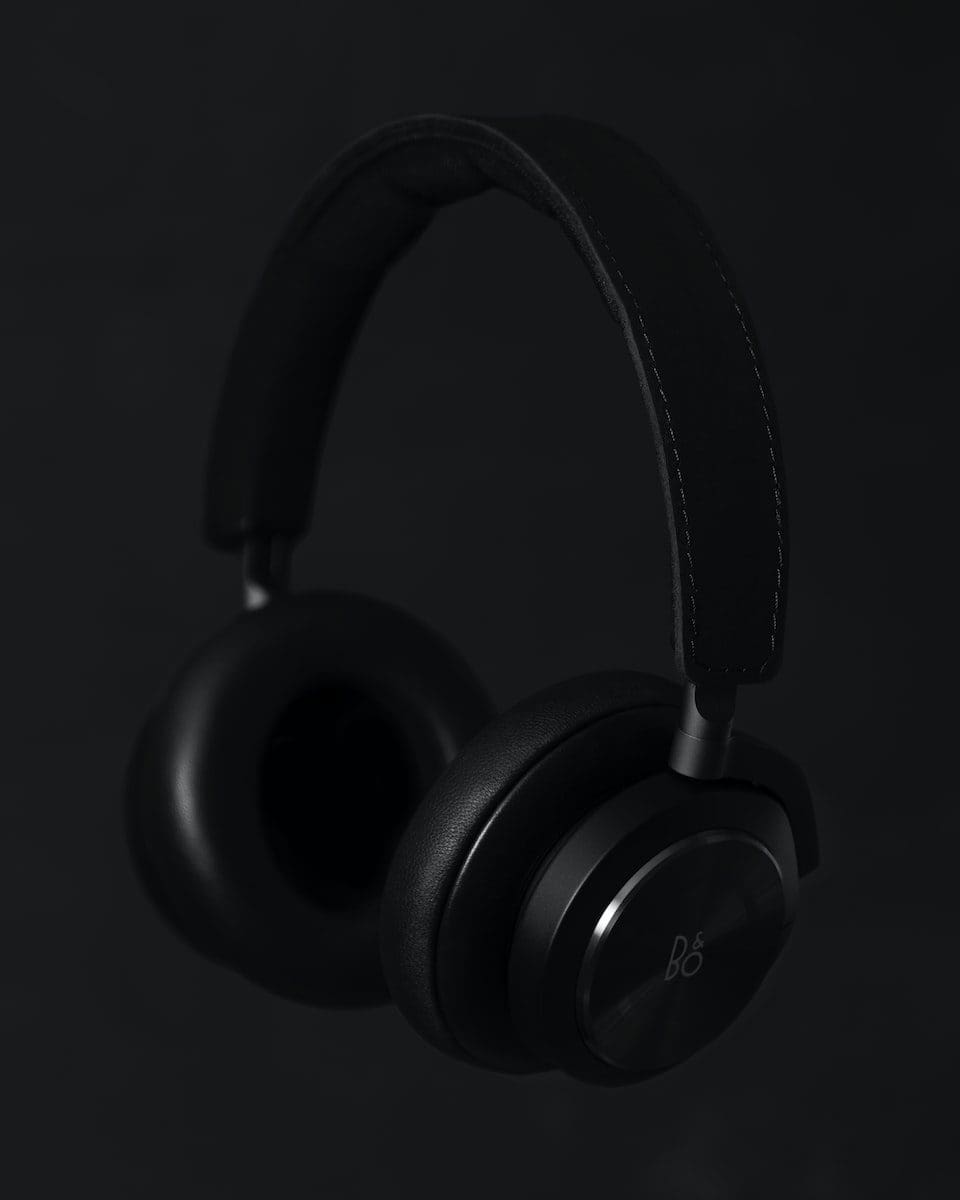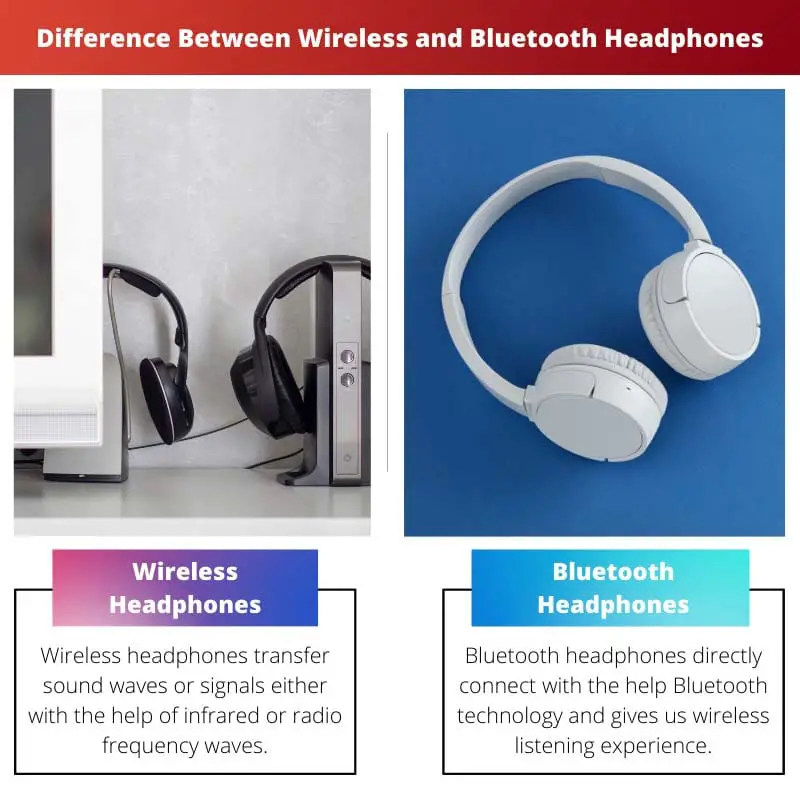We all get confused with wireless and Bluetooth headsets. But it is very important to differentiate between them. Headphones are necessary for every user and are used daily.
Key Takeaways
- Wireless headphones use various technologies, such as Bluetooth, radio frequency, or infrared, for audio transmission without cables.
- Bluetooth headphones use Bluetooth technology for connectivity, offering compatibility with various devices.
- Although both types eliminate the need for cords, Bluetooth headphones have shorter ranges and lower audio quality than other wireless technologies.
Wireless vs Bluetooth Headphones
A wireless headphone is a type of headphone that can connect to an audio source, such as a smartphone, without the need for a physical cable. A Bluetooth headphone is a type of wireless headphone that uses Bluetooth technology to establish a wireless connection with an audio source.

Wireless headphones are paired or connected with a device through a radio or infrared signal. They cover a long range depending on the environmental barriers.
On the other hand, Bluetooth headphones are those that connect one device to another device with the help of Bluetooth. It covers a small radius depending upon its surroundings.
Comparison Table
| Parameter of Comparison | Wireless Headphones | Bluetooth Headphones |
|---|---|---|
| Definition | All wireless devices are not Bluetooth devices. | All Bluetooth devices can be called wireless |
| Technology | Wireless headphones require an adaptor to attach to the device. | Usually, by default, Bluetooth is built inside the device. |
| Sound quality | It uses either infrared or radio waves to transfer audio signals. | It used radio waves to transfer audio signals. |
What is Wireless Headphone?
Wireless headphones transfer sound waves or signals either with the help of infrared or radio frequency waves.
Infrared waves work exactly like your TV remote, i.e. transfers signals to the headphones from the base unit. The operating range is limited, i.e. limited motion should be present within a distance of 7 meters or less between the transmitter and headset.
Radio waves are more powerful and work in a broader range, making walking around in the house trouble-free. The range is considerably better, i.e. up to 300 feet if the environment is problem free.
They work without cable or wire and get the sound waves from a base joined to a device such as a speaker, smartphone, gaming console, or computer. They work on a set of standard batteries.
They can be charged or easily replaced when they stop working.
They are smaller and can be worn close to your ears. Hence it helps us listen to various sounds of movies, music, videos etc.
They are also known as cordless headphones as they work without any wire or cord and use radio frequency waves to transfer the sounds.
When we talked about wireless headphones in the past, we referred to headphones with a microwave/infrared receiver that worked with the help of a transmitter.
Such headphones are still present in the market as Bluetooth connections are of a small range and can cause delays.
Many wireless technologies around us, such as gaming headphones, do not require Bluetooth.
The origin of villages can be traced from early human history, when agriculture started, cattle rearing and other domestic works.
Villages are not populated, houses over there are not too modern, neither have multi-floor buildings, and the livelihood of people of the village is relatively simple.

What is Bluetooth Headphone?
One of the most impressive wireless technologies is Bluetooth which works in a short or limited range but can connect to multiple devices using radio waves without wires or cables.
The technology helps send and get data with the help of devices such as smartphones, laptops, tablets, etc., that have Bluetooth in them.
Bluetooth headphones directly connect with the help of Bluetooth technology and give us a wireless listening experience.
We found this technology in almost every hi-tech modern device, such as laptops, smartphones, and speakers, and it covers short or limited ranges.
Bluetooth radio is present in small computer chips in devices that help connect with each other. We get confused between wireless and Bluetooth devices as they are synonymous.
Bluetooth headphones work so that each earbud works without a wire and directly connects to the phone.
Some the Examples of these headphones are Apple Airpod, Bose SoundSport Wireless, Sennheiser Momentum True Wireless etc.

Main Differences Between Wireless and Bluetooth Headphones
- All wireless devices are not Bluetooth devices, whereas All Bluetooth devices can be called wireless.
- Wireless headphones require an adaptor to attach to the device, whereas Usually, by default, Bluetooth is built inside the device.
- Wireless headphones use infrared or radio waves to transfer audio signals, whereas Bluetooth headphones use radio waves to transmit audio signals.
- Wireless headphones cover a broad radius of up to 300 feet, depending on the environmental barriers. In contrast, Bluetooth headphones cover a small radius of up to 30 feet or less, depending on the surroundings.
- Wireless headphones are not always compatible with all devices as it depends on the inbuilt of other devices, whereas Bluetooth headphones are compatible with most Bluetooth-enabled devices.

- https://www.ncbi.nlm.nih.gov/pmc/articles/PMC4285000/
- https://educateemf.com/are-bluetooth-headphones-safe/

The distinction made in the article between wireless headphones using radio or infrared signals and Bluetooth headphones provides valuable insights into their functionalities. Well done.
I appreciated the author’s emphasis on the practical applications of wireless and Bluetooth headphones. It’s rare to find such informative content.
The article effectively delineates the distinctions between wireless and Bluetooth headphones, providing a comprehensive understanding of their functionalities and technologies.
The in-depth exploration of both wireless and Bluetooth headphones in this article is highly commendable. The author’s knowledge and analysis are evident throughout the piece.
The article presents a logical, well-structured comparison between wireless and Bluetooth headphones. It’s a testament to the author’s expertise in the subject.
The description of wireless headphones using radio and infrared waves was particularly interesting. The article effectively distinguishes the features of these technologies.
I appreciated the historical context provided about the evolution of wireless headphones. It shed light on how the technology has progressed over time.
I found the information on the different technologies used by wireless and Bluetooth headphones to be quite helpful. Understanding the specifics of their connectivity is crucial for consumers.
The article’s explanation of the ranges covered by wireless and Bluetooth headphones was enlightening. It’s fascinating to see how different technologies offer varying connectivity capabilities.
I think it’s important to emphasize the distinction between wireless headphones and Bluetooth headphones to dispel any confusion. This article does a great job of that.
The article’s explanations of how wireless and Bluetooth headphones function were both engaging and educational. It’s clear that a lot of thought went into the content’s presentation.
I agree, the descriptions of the technologies involved served to demystify the differences between wireless and Bluetooth headphones. An excellent read.
The article’s ability to simplify complex technology into understandable terms is commendable. I feel much more informed about wireless and Bluetooth headphones now.
I appreciate the depth of detail offered in this article. It’s clear that the author has a strong grasp of the complexities involved in wireless and Bluetooth headphones.
This article is very informative about the difference between wireless and Bluetooth headphones. It’s important to understand the distinction, and the comparison table was especially helpful.
I agree, the practical examples of each type of headphone really reinforced the concepts presented in the article.
Yes, the article provided a clear and detailed explanation of the technologies involved in wireless and Bluetooth headphones. Very insightful.
This article offers a comprehensive comparison between wireless and Bluetooth headphones, bringing clarity to their technological differences.
The information on the operating ranges of wireless and Bluetooth headphones was crucial in understanding their practical applications. The article has been quite enlightening.
The examples of wireless and Bluetooth headphones provided in the article were very useful in illustrating the differences. It’s rare to see such detailed comparisons.
I found the breakdown of the range of radio waves used by Bluetooth headphones to be quite fascinating. The article provides a solid understanding of the underlying technologies.
The article effectively differentiates between wireless and Bluetooth headphones, offering comprehensive technical details that are accessible and easy to understand.
I found the comparison between wireless and Bluetooth headphones to be quite thought-provoking. The article certainly broadened my knowledge on the topic.
It’s refreshing to read a piece that provides both detailed technical information and practical examples. The article’s focus on clarifying the differences is highly valuable.